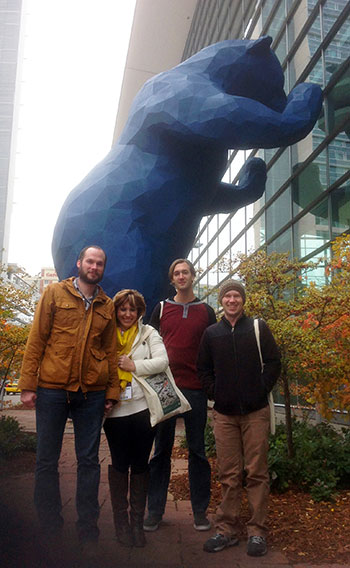 |
| Presenters Nathan Renfro (with wife Holly), Troy Ardon and Dr. Christopher M. Breeding (aka Mike), all of the GIA laboratory in sunny Carlsbad, CA, brave the cold wind outside the convention hall the day before the gemological session starts. Mike’s talk on green diamonds typified the high quality of presentations during the Session (see abstract). They stand before “I see what you mean” blue bear sculpture by Lawrence Argent. (Photo: E.A. Skalwold) |
Gemology Bears Triumphant Tidings
from the Historic 125th Anniversary Annual Meeting of the Geological Society of America
Elise A. Skalwold, BSc, FGA, GG
Access a PDF of this article here.
With its first-ever dedicated session and with the sponsorship of the Gemological Institute of America (GIA), gemology made significant progress towards recognition as a formal science by the mainstream geo-sciences community during this fall’s Geological Association of America’s (GSA) historic 125th Anniversary Annual meeting held October 27–30, 2013, in Denver, Colorado.
Founded in 1888 in Ithaca, New York, the GSA is one of the oldest and most important geo-science professional organizations world-wide. This year’s huge gathering of over 8,000 people in Denver’s immense Colorado Convention Center was auspicious in many, many ways, not least of all for those whose interests are rooted in the science of gems.
Under the enigmatic gaze of a 40-foot-high blue bear peering through the Center’s glass façade, conference delegates were offered a mind-boggling selection of sessions in which to participate, each comprised of dozens of oral presentations and poster presentations covering a wide range of important developments and cutting-edge research in the geological sciences.
A record number of abstracts (purportedly over 4,000) were submitted for the GSA’s meeting this year and the selection accepted for inclusion made for hard choices of what to attend over the jam-packed four days of the conference. Despite this, our science of gemology successfully carved a niche of its own, attracting an impressive number of conference attendees with its awesome line-up of presentations for its session entitled “Gemological Research in the 21st Century: Characterizing Diamonds and other Gem Minerals.” The Session’s mission statement declared “Gemstones are the most recognized, sought after, and highly valued of all minerals. This session will focus on characterizing the properties of gems, documenting their conditions of formation, and improving the means of their identification.”
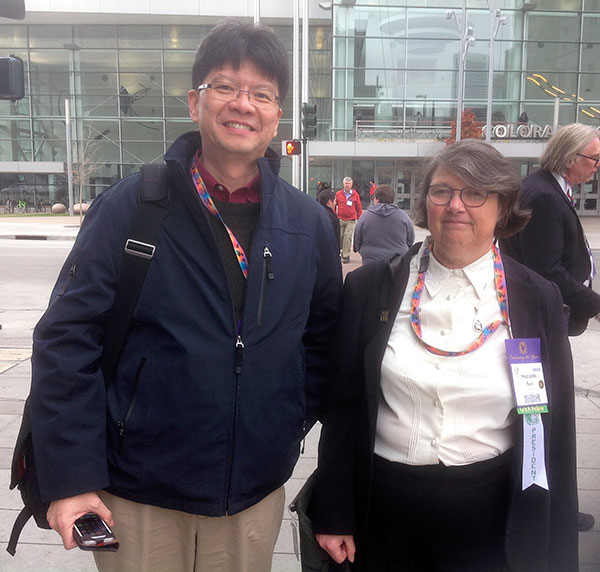 |
| Dr. Andy Shen, formerly of GIA, now Distinguished Professor in the Institute of Gemology, China University of Geosciences (Wuhan) traveled far indeed to deliver his talk on origin determination (see abstract). He is pictured with GSA’s president Dr. Suzanne Mahlburg Kay, Professor of Geological Sciences, Cornell University, in the same Department of Earth and Atmospheric Sciences where Dr. Shen earned his PhD in 1994 under the guidance of Dr. William A. Bassett, Professor Emeritus, and which is the home of the Heasley Museum of Mineralogy. While at Cornell, Dr. Shen was an early advocate of gemology’s relevance in the university setting. (Photo: E.A. Skalwold) |
The Session was broken into two formats spread over two days. The first was a morning of oral presentations consisting of 12-minute PowerPoint talks, each followed by 3 minutes of questions and answers. While Session conveners Dona Dirlam and Dr. James E. Shigley of the GIA served as hosts charged with enforcing the strict schedule imposed by the GSA Conference format, neither needed to crack the whip, such was the skill of each of the thirteen people who delivered succinct, fascinating presentations on a variety of pertinent gemological topics.
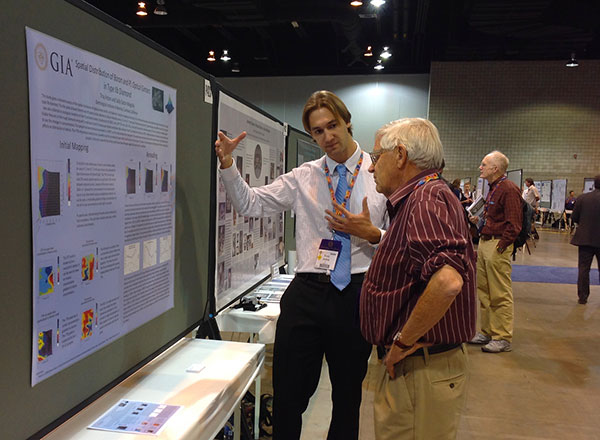 |
| GIA Staff Gemologist Troy Ardon enthusiastically discusses his research involving detailed analysis of the spatial distribution of optical centers within a IIb diamond (see abstract). His captive audience is Dr. Richard B. Berg, Senior Research Geologist, Emeritus, of the Montana Bureau of Mines and Geology, who gave his own presentation on Montana sapphires during the previous day’s oral gemological presentations (see abstract). (Photo: E.A. Skalwold) |
An informal headcount during the program put the audience attendance at around 80 at any one time and about 100 distinct personages, as some came and went due to other desired talks scheduled for the same timeslot. This is an extremely impressive turnout and gratifying reward for the efforts of the people who put a great deal of work into their presentations and came from long distances in order to participate (see the speaker line-up with links to abstracts of their papers).
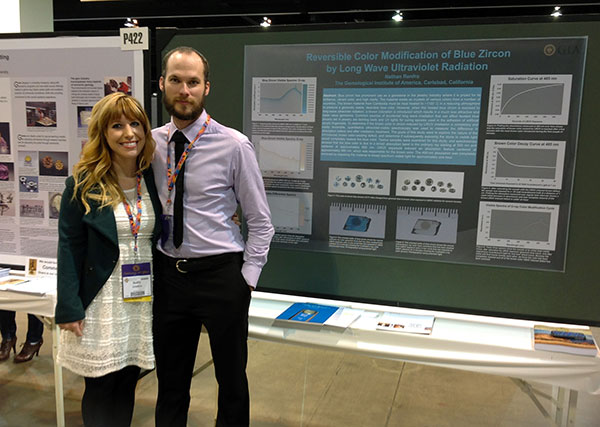 |
| A beaming Holly and Nathan Renfro, Lead Analytical Specialist of colored stones at GIA, stand before his presentation on Reversible Color Modification of Blue Zircon by LW UV Radiation (see abstract). While a steady stream of geo-scientists were drawn to his topic and bent his ear with questions, this topic will surely be of great interest to gemologists and to those in the gem world interested in zircon and gem treatments. (Photo: E.A. Skalwold) |
The Session’s second day of presentations was given in the form of posters which overviewed current research in the gemological sciences (see abstracts of the papers). While at first glance perhaps a less structured, simpler venue, this format entailed significant time and effort on the part of its participants in order to fit complicated concepts into visually appealing, yet informative posters within a limited space of 4 x 8 feet; in many ways analogous to the 12-minute presentations of the previous day. One presenter was heard to say that s/he could not have previously imagined the difficulty of such a task and in the future would rather put together an hour long talk spread over many slides, while another declared that a poster was much better suited to the topic at hand since its wider breadth was not possible to attain in a mere 12-minute oral presentation!
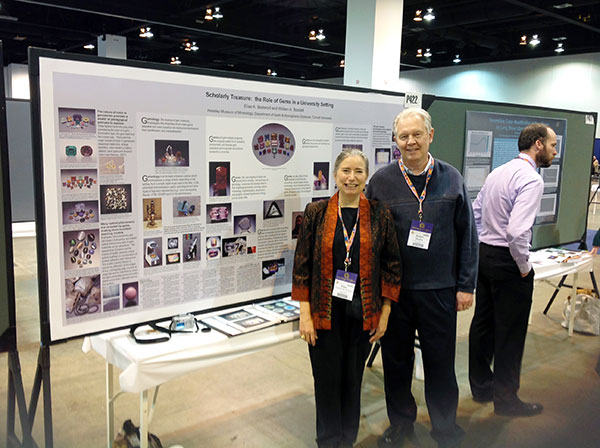 |
| The author with Session co-convener Dr. James E. Shigley, Distinguished Research Fellow, GIA. Dr. Shigley could not have been more pleased with the success of the Session and expressed hopes for future similar endeavors. (Photo: E.A. Skalwold) |
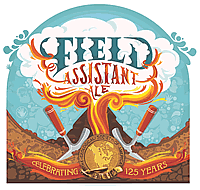 |
Posters also appealed to those who desired to have more time to interact with smaller audiences or to talk one-on-one with interested colleagues. Since this lasted the entire day and was quite exhausting, thirsty presenters and audience alike appreciated the daily beer receptions featuring Colorado's own Left Hand Brewing Company’s GSA’s 125th Anniversary brew, “Field Assistant Ale.”
Unfortunately, unable to make the trip from China was Dr. Ren Lu, formerly of GIA, now of the Institute of Gemology, China University of Geosciences (Wuhan). The abstract for his paper may be viewed here.
In addition to the formal presentations and events, informal gatherings were held throughout the four days just about everywhere. Academic and geo-science organizations hosted special talks and receptions, including the GIA, which hosted a dinner reception for the local Colorado Mile High chapter of the GIA Alumni Association and other local members of the gem trade. This offered a chance for those not able to attend the GSA conference to meet the Session presenters and to talk about issues relating to gemology.
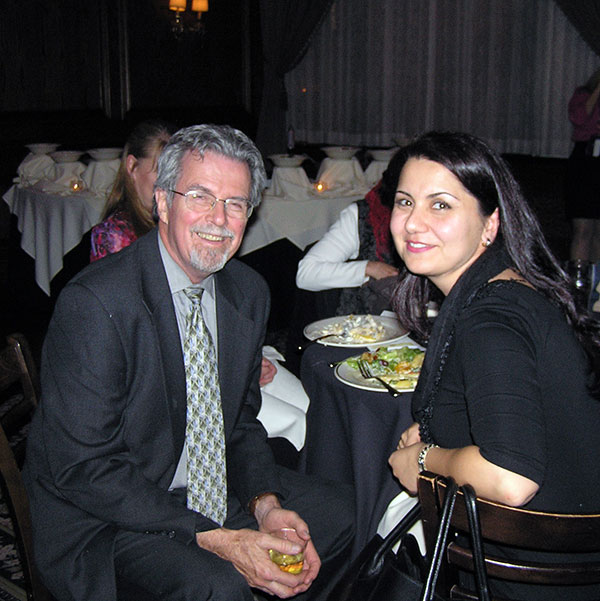 |
| Above: Mile High GIA Alumni Association member and appraiser William Lacert and Session presenter Dr. Cigdem Lule of Gemworld International. Below: Session co-convener Dona Dirlam, director of GIA’s Richard T. Liddicoat Gemological Library and Information Center, with presenters Dr. Sally Eaton Magaña and Dr. Andy Shen, along with GIA research scientist Dr. Troy Blodgett and this author. Dr. Lule’s presentation on trace element analysis techniques related to archeogemology neatly dovetailed with Dr. Shen’s presentation which followed (see abstracts). GIA research scientist Dr. Magaña is also co-author of the historical fiction diamond thriller “Lost Hope,” reviewed here by Kristi and John Koivula. (Photos: E.A. Skalwold) |
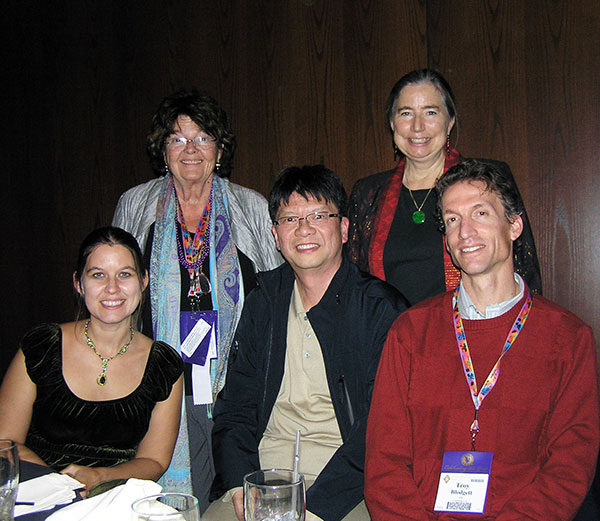 |
A high point of the conference for this author was the attention given to her presentation by Dr. Mickey Gunter and Session presenter Dr. Frank Hawthorne (see abstract). Dr. Hawthorne is this year’s Roebling Medalist, the highest honor given in the field of mineralogy, an honor also bestowed on this author’s poster co-author Dr. William A. Bassett, her collaborator on many gemologically-related endeavors. Dr. Hawthorne is widely recognized for his work in crystallography and has often authored publications pertinent to the gem world. Similarly, Dr. Mickey Gunter, Department Chair & Professor of Mineralogy & Optical Mineralogy at the University of Idaho, not only is the co-author of one of the most gemologically relevant, outstanding textbooks on mineralogy and optical mineralogy, his interest in gem materials is evident in his contributions to the monographs published by Lithographie on Garnet (Idaho’s “Star” Garnet) and Calcite (“A lucky break for polarization: The optical properties of calcite”). The latter was in part a source of inspiration and correspondence related to this author’s longtime interest in calcite as the mineral theoretically used by the Vikings as a navigation aide, first proposed by Leif Karlsen in 2003 (see “The Fabled Viking Sunstone”); a concept ripe with possibilities as a teaching model for optical properties of gems and minerals.
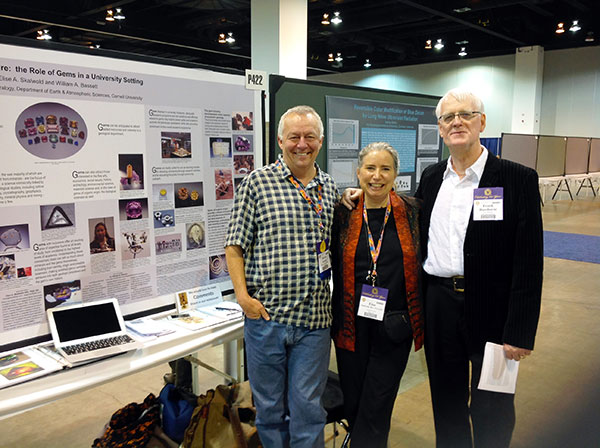 |
| The author at her poster presentation with optical mineralogist Dr. Mickey Gunter and fellow Session presenter, Roebling Medalist Dr. Frank Hawthorne. Great fun was had when the former pulled up a chair to stay for a while in order to discuss optical properties of gems, including examination of Norwegian geologist Asbjørn Halvorsen’s original specimens of the enigmatic Usambara Effect tourmalines, brought along for show-and-tell. (Photo: E.A. Skalwold) |
While not the first time that individual gem and gemology related topics have been presented at the GSA—notably such papers as Annibale Mottana’s 2006 “Italian gemology during the Renaissance: A step toward modern mineralogy” (see abstract)—2013 marks the first time a session exclusively devoted to the science of gemology has been officially part of the GSA meeting. This is an auspicious and historic event in its own right within the larger context of the GSA’s history and statement of purpose. Future such participation in this and other mainstream geo-science conferences could lead to wider formal acceptance of gemology as a science unto to its own, with all the advantages of such status, including the conferring of academic degrees and awarding of funding for gemological research, all of which will benefit the gem industry. In any event, more people will come to recognize the value of gem materials and related topics to a variety of academic and pedagogical pursuits.
Along with hearty congratulations, sincere gratitude is offered to session conveners Dona Dirlam and Dr. James E. Shigley, and session sponsor, the Gemological Institute of America, for their invitation to participate in this historic event of the GSA in which gems and gemology have now found their own place.
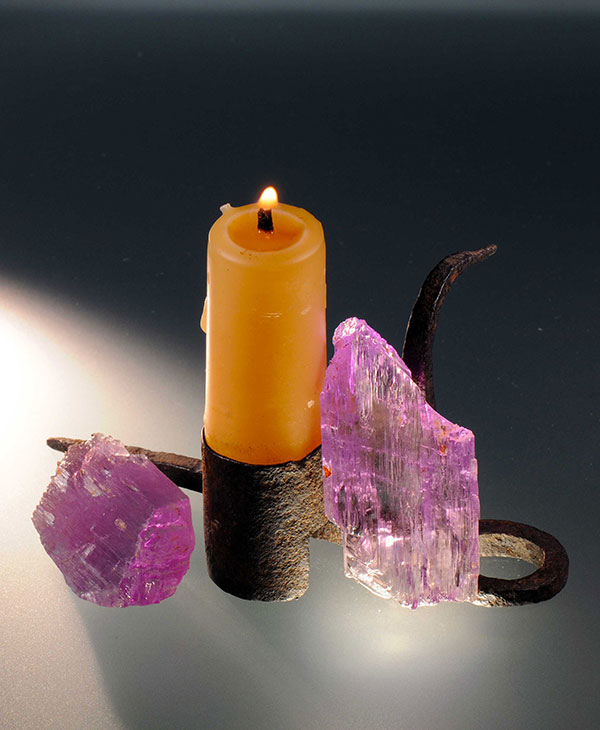 |
| A miner’s lamp of more than a century ago along with the gemmy crystals of kunzite spodumene he might have sought in the dark depths of a Californian mine. From the author’s GSA Paper No. 375-3 “Scholarly Treasure: the Role of Gems in a University Setting.” It is hard to believe that sometimes all a miner had to work by was a candle. I am glad that I work above ground, but it is sobering to remember where the things I study so intently originate. These were mined by a friend with modern gear and I am very thankful to have them; I am very mindful of that when I use them to demonstrate gem mineral properties. It is a bit of a keystone for my Denver trip. (Photo: E.A. Skalwold) For the best article about these crystals, see Rocks and Minerals magazine: “The History of Kunzite and the California Connection” by Mark Mauthner. |
About the author: Elise A. Skalwold is an author and Accredited Senior Gemologist (AGA) involved in curating and research at her alma mater, Cornell University, Class of 1982. She is a Fellow of the Gemmological Association of Great Britain (FGA), having trained in residence at the Gem & Jewelry Institute of Thailand (GIT) campus in Bangkok, Thailand. She is also a Graduate Gemologist (GG), trained in residence at the Gemological Institute of America (GIA) Robert Mouawad Campus located in Carlsbad, CA, and is a member of the Society of Mineral Museum Professionals (SMMP).
Note: Palagems.com selects much of its material in the interest of fostering a stimulating discourse on the topics of gems, gemology, and the gemstone industry. Therefore the opinions expressed here are not necessarily those held by the proprietors of Palagems.com. We welcome your feedback.